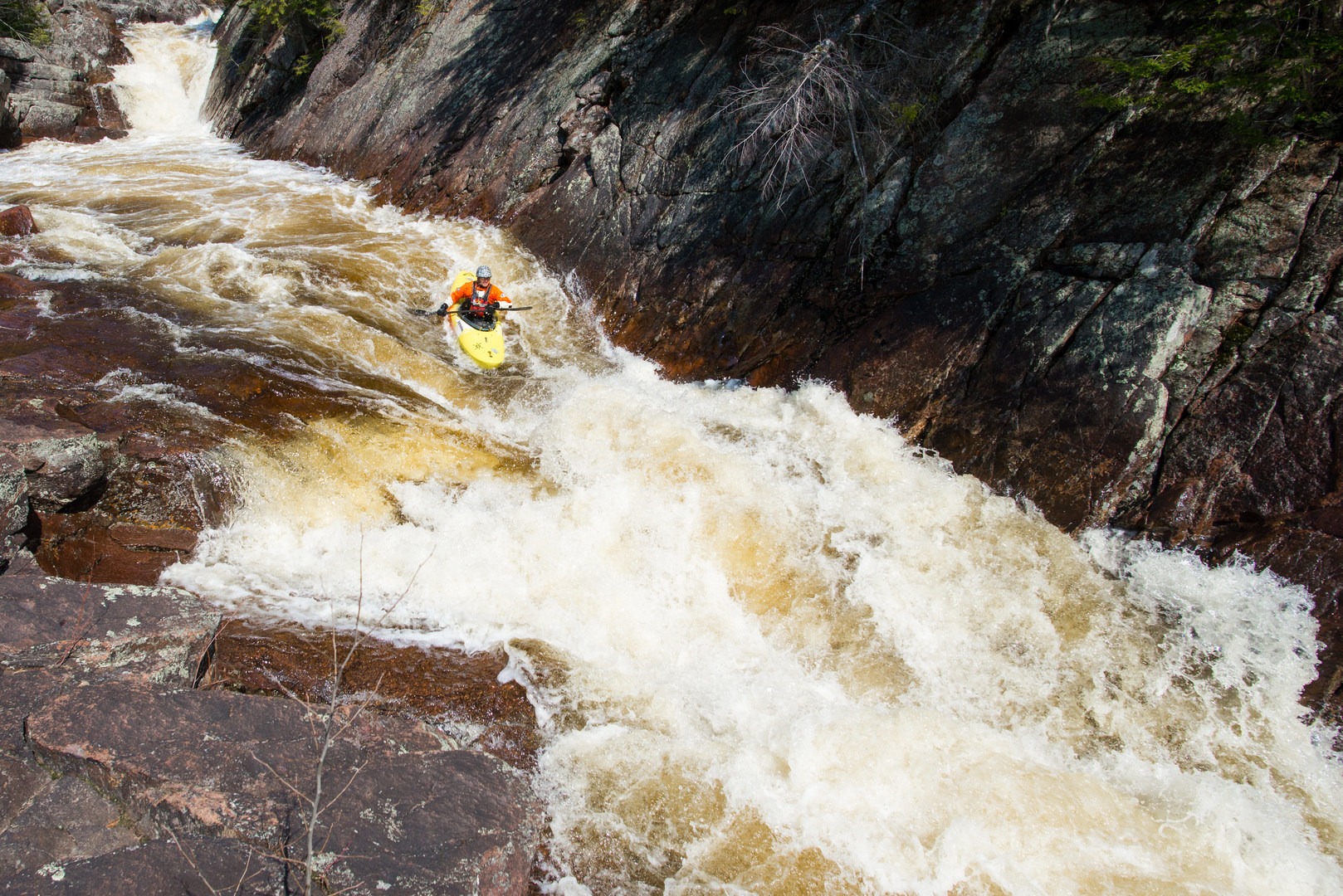You are here
The Middle Branch of the Oswegatchie is a textbook example of New York pool-drop whitewater. It's also one of the very best! Big waterfalls, funneling slots and powerful holes break up long sections of flatwater here, and there is gorgeous scenery, a remote feel, and just enough going on between the major rapids to keep things interesting. Unfortunately, the gauge for this stretch is notoriously unreliable, and it's easy to get skunked with flows on either end of the recommended window.
The middle branch is divided into four sections. The top two are rarely paddled and feature Class II and Class III rapids with lots of flatwater between. Section Three is paddled slightly more often, but a gate on the shuttle road is often closed early in the spring when the river is running. Section Four is more accessible, shorter, and features the best whitewater. With a short hike, it's possible to add the marquee drop from Section Three to a run down Section Four.
Those eager to get the most out of their day on the Os can park a car at the bridge on the Bryant Bridge Road where it crosses the Oswegatchie and intersects with the Bald Mountain Road. From here, begin hiking up the Bryants Bridge Road as it continues upstream on river left. About 0.7 miles up, follow a spur trail into the woods on the left to reach the top of Rainbow Falls.
A 12-foot ledge (IV+) with a surprisingly powerful hole and a short but steep slide that immediately follows provides a warm-up for the big drop below. The lip of Rainbow Falls itself looms just downstream, so be confident you can catch an eddy on the right or the left.
Rainbow Falls (Class V) is an approximately 40-foot cascade typically run on the right. The lip is broken and chaotic, but it generally goes better than you might expect. The landing zone has a calm pocket on river right that often catches swimmers, but it can be challenging to escape. The rest of the river continues down over shallow Class II+ for about 100 yards.
Flatwater and occasional riffles escort paddlers to the typical put-in for Section 4 at the bridge where the cars are parked. The flatwater continues just out of sight before reaching Trash Can Falls (Class V+), a junky ledge with offset holes, unfortunate flakes of rock, and a shallow landing. Scout from the island in the middle, and consider the sneak (Class IV) in the left channel.
Flatwater resumes until the river makes a sharp bend to the left and over a 4-foot ledge called Cable Boof (Class IV) for the obvious and dilapidated cable bridge just upstream of the ledge. The hole is quite sticky, but a phenomenal boof on the left makes it easy to avoid.
Just around the corner, the Tooth Ferry (Class IV+) lurks. This drop funnels into a narrow mini-gorge with a huge hole at the bottom. The rapid was named after a prominent local paddler hit a barely submerged rock and lost his tooth. Scout carefully from the right.
Dick Rock (Class IV) follows, a slide with a turbulent hole waiting at the bottom. A few more mild unnamed rapids keep the pace moving, with Phil's Hole (Class IV+) ending the boogie. While this ledge isn't especially difficult, the hole it creates is one of the worst on the river. Drive left early (but not too early) to avoid the worst of it.
Just downstream, another massive horizon unfolds. Panther Falls (Class IV+), though intimidating, is among the easiest of the big drops on the run. Scout from the right to find your landmarks and head right down the middle of this over 40-foot slide.
Below Panther the flatwater picks up once again, this time just long enough for paddlers to let their guard down. Get out to scout on the right just above where the river makes a hairpin turn to the left. Sluice Falls is hidden just around the corner.
Sluice Falls (Class V+) is a fascinating spectacle of whitewater. The entire river makes a 110-degree turn to the left, pillowing up against bare bedrock walls and funneling down into a crack barely 6 feet wide. Just downstream it pinches up again, creating a vague replica. The folding currents are intimidating to say the least, and they offer enough challenge to keep even the best paddlers on their toes.
Lower Sluice Falls (Class V) has a wider lip and a more powerful cross current and hole at the base. Both of these can be portaged on the right.
An unnamed Class IV rapid awaits those who run Lower Sluice Falls, with a few offset holes, and crashing diagonal waves.
The flatwater resumes for another long stretch before the final rapid, Roshambo (IV-), a short boulder garden with multiple lines. The left is most forgiving, but it can have a sticky hole at certain flows.
About 3 miles of flatwater temper the excitement paddlers feel after Sluice Falls, but not quite enough to keep them from coming back.
For shuttle: From the take-out on Jerden Falls Road, continue to the Bryant Bridge Road on the northeast side of the river. Turn right onto Bryant Bridge Road for 3.7 miles. Turn left after crossing the bridge to park near the gate. This is the regular put-in for Section 4.








Comments
Sign In and share them.